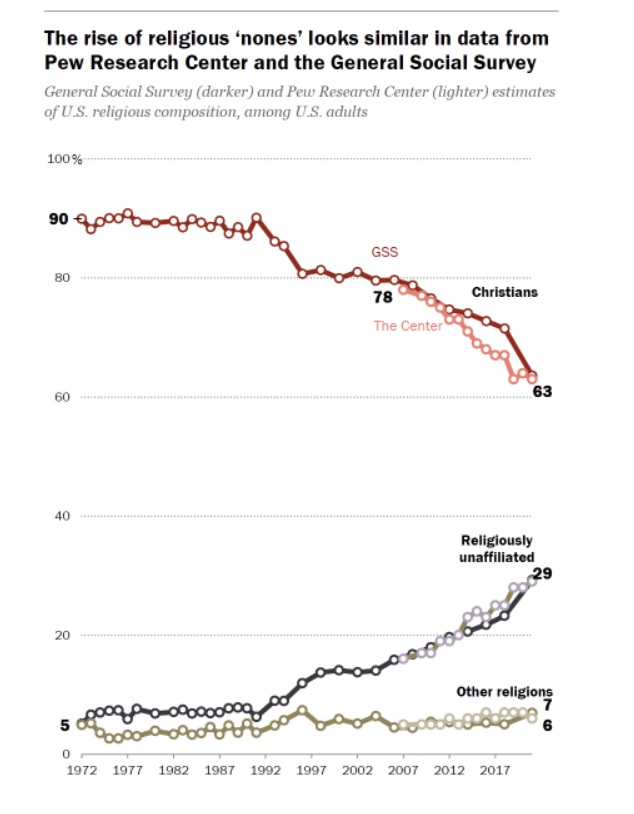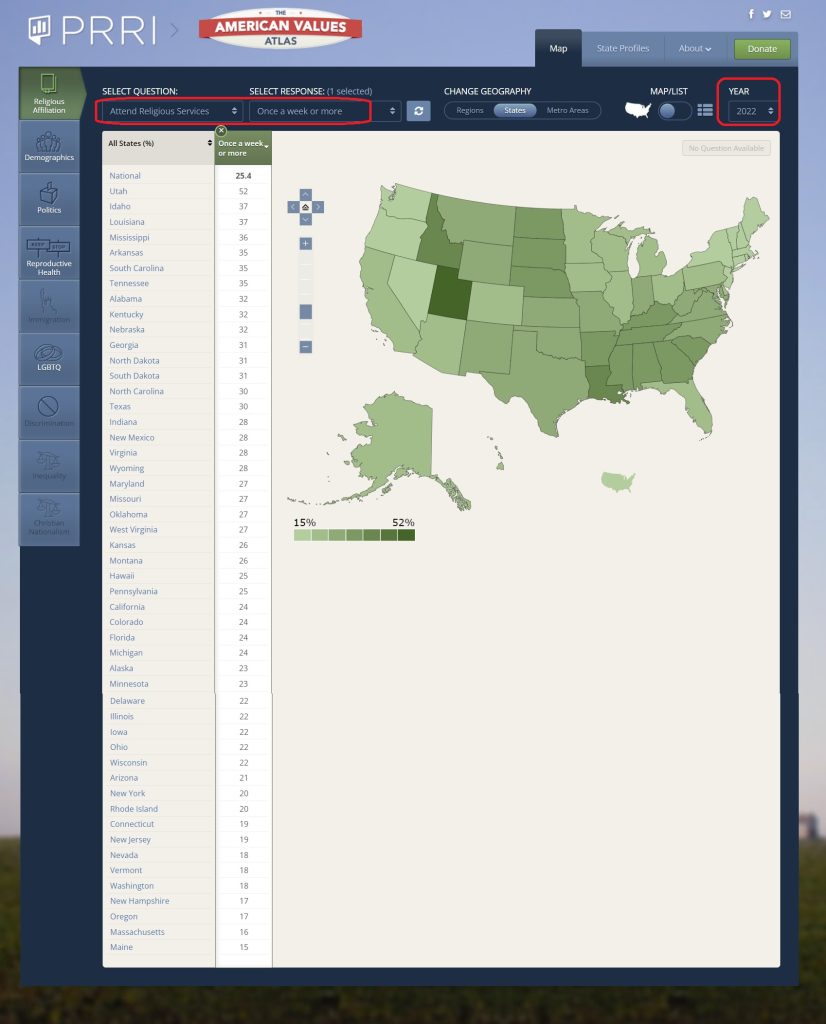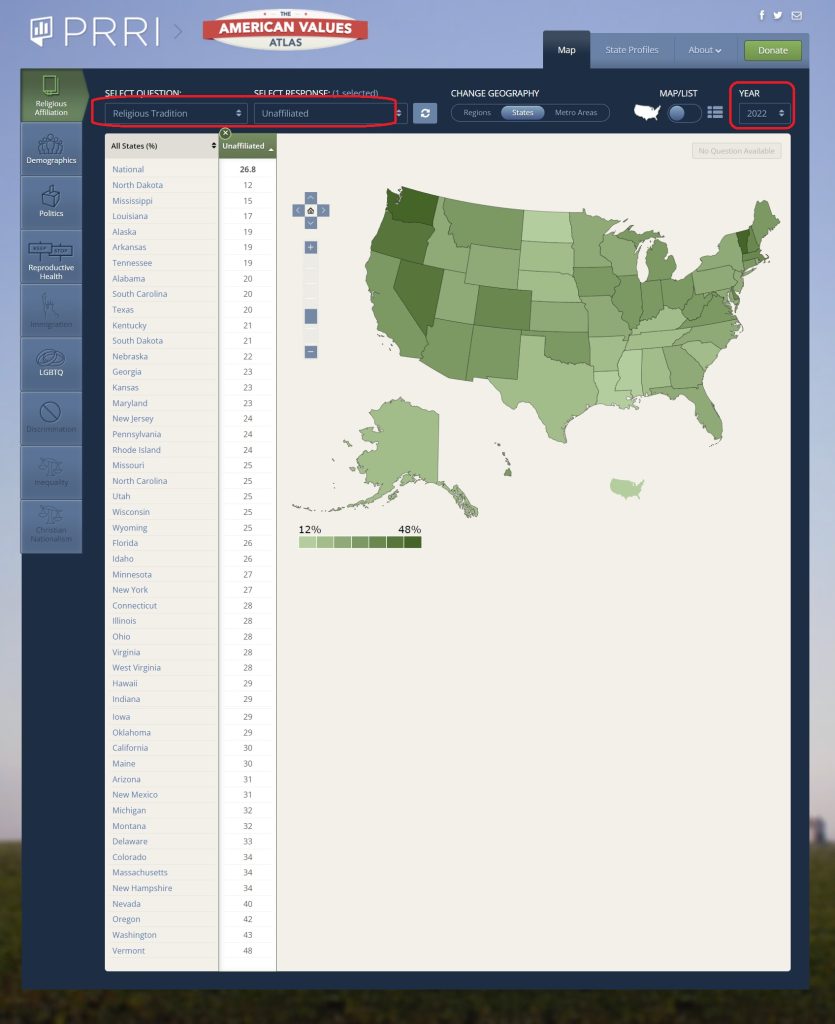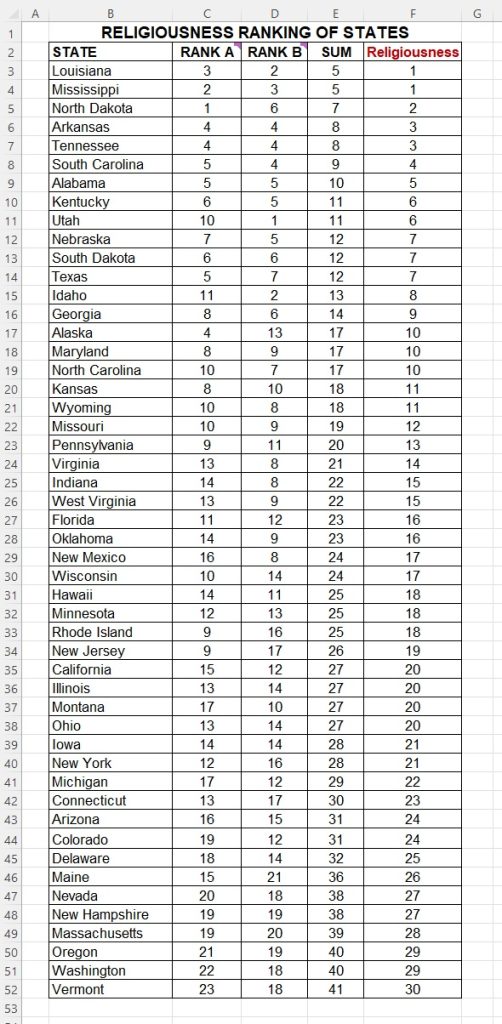Religiousness in TIME and SPACE
Many people believe that religion makes people morally good, happy, and mentally healthy, but I’m not so sure.
Obviously, there are some very good, very happy, and mentally healthy atheists and non-religious people, and there are also some very bad, very miserable, and seriously mentally ill religious people. The same can be said of Christians in particular: there are some very bad, very miserable, and seriously mentally ill Christians.
Religion does NOT guarantee moral goodness, happiness, and mental health, and Christianity does NOT guarantee them either. Nevertheless, many would claim that religion in general, or Christianity in particular, makes a significant difference in the lives of many people, helping them to be morally good, happy, and mentally healthy.
I don’t think so. I doubt this common belief. In any case, there is quite a bit of evidence that points in a different direction.
I think it is helpful to look at religion and Christianity in terms of both TIME and SPACE, to determine whether the widely held belief that religion (or Christianity) helps people to be good, happy, and mentally healthy is true or false, reasonable or unreasonable:
- IN TERMS OF TIME, we have the important fact that religion and Christianity have been decreasing in the USA in recent decades. So, we can compare the goodness, happiness, and mental well-being of people in the USA now, with the goodness, happiness, and mental well-being of people in previous decades. If the belief that religion or Christianity helps people to be good, happy, and mentally healthy is true, then we should expect to find that goodness, happiness, and mental health have been in decline over the past three or four decades.
- IN TERMS OF SPACE, we have the important fact that religion and Christianity are significantly more prevalent in some states than in other states in the USA. So, we can compare the levels of goodness, happiness, and mental well-being of people in states where religion and Christianity are most prevalent with the levels of goodness, happiness, and mental well-being of people in states where religion and Christianity are least prevalent. If the belief that religion or Christianity helps people to be good, happy, and mentally healthy is true, then we should expect in states where religion or Christianity is most prevalent that the levels of goodness, happiness, and mental well-being would be significantly better than in states where religion or Christianity is least prevalent.
RELIGION HAS BEEN DECREASING IN THE USA IN RECENT DECADES
The Pew Research Center produced a graph that shows that both religion and Christianity have been declining in the USA for at least three decades:

The above graph is from: “Modeling the Future of Religion in America” a report by the Pew Research Center (released September 2022): https://www.pewresearch.org/wp-content/uploads/sites/20/2022/09/US-Religious-Projections_FOR-PRODUCTION-9.13.22.pdf
Note that the percentage of Americans who consider themselves Christians has steadily decreased from 90% in 1991 to just 63% in 2021. This is a clear indication that Christianity has been in significant decline in the USA for at least the past three decades.
Note that the percentage of Americans who are religiously unaffiliated (called “Nones”) has steadily increased from 6% in about 1990 to 29% in 2021. This is a clear indication that religion in general has been in significant decline in the USA for at least the past three decades.
RELIGION AND CHRISTIANITY ARE SIGNIFICANTLY MORE PREVALENT IN SOME STATES IN THE USA COMPARED WITH OTHER STATES IN THE USA
In February of 2016, the Pew Research Center published an article (“How Religious is Your State?”) in which data from the Pew Research Center’s “Religious Landscape Study” was used to rank all 50 states in the USA from the most religious state (Alabama) to the least religious state (New Hampshire):
The data from the “Religious Landscape Study” was used to determine the percentage of people in each state who were “highly religious”. The state with the highest percentage of such “highly religious” people was ranked as the most religious state, and the state with the lowest percentage of “highly religious” people was ranked as the least religious state, and the other states were ranked between these two extremes based on the percentage of “highly religious” people in those states.
They used multiple criteria to determine whether a particular person was “highly religious” or not:

(The above quote is from the article “How Religious is Your State?“)
Seems like a reasonable way to define “highly religious”, and a reasonable way to rank states from most religious to least religious (based on percentage of people in the state who were “highly religious”).
Given this definition of a “highly religious” person, the authors of the article were able to determine, using data from the “Religious Landscape Study” that 77% of the people (adults) in Alabama were “highly religious” while only 33% of the people in New Hampshire were “highly religious”. Clearly, there is a huge difference between a state where more than three-quarters of the people are “highly religious” and a state where only about one-third of the people are “highly religious”. So, this analysis shows that there are significant differences in the prevalence of religion between the states in the USA.
There were, of course, states covering this wide range between 77% being highly religious and only 33% being highly religious. Some states were in the 60-70% range, some states were in the 50-60% range, other states were in the 40-50% range, and some were in the 30-40% range. Thus, the 50 states can potentially provide us with significant data about the alleged effects of religion and Christianity on people’s lives.
I think the definition of “highly religious” people used in the above article is reasonable, and the data from the “Religious Landscape Study” was good and useful data for making this ranking of states from the most religious (Alabama) to the least religious (New Hampshire).
However, the data in the “Religious Landscape Study” was collected in 2014, and it is now 2024. So, that data was from a decade ago! It is quite possible that there have been significant changes over the past decade, so the ranking of states done based on the 2014 “Religious Landscape Study” is now out of date, and might not reflect our current reality in the USA.
Therefore, I have located some more recent data (from 2022) and constructed my own ranking of the states from the most religious state to the least religious state, so that we can better examine the question of whether religion in general, or Christianity in particular, provides significant help to people to be good, happy, and mentally healthy.
MY RANKING OF THE RELIGIOUSNESS OF THE 50 STATES IN THE USA
I have found some current data on religion in the USA from an organization called Public Religion Research Institute (PRRI):
Founded in 2009, Public Religion Research Institute is a 501(c)(3) nonprofit organization that produces high-quality research analyzing Americans’ attitudes at the intersection of religion, values, politics, and public life.
PRRI provides easy online access to their data on religion in the USA, and they have data from recent years: 2021, 2022, and 2023. Their data does not cover as many questions as the data in Pew Research Center’s “Religious Landscape Study” from 2014, but the data from PRRI is relevant to determining a ranking of states from most religious to least religious, and I believe their data is sufficient for this purpose.
The PRRI data includes the question of how frequently a person attends religious services. This is relevant to determining the degree of religiousness of a state. The greater the percentage of people in a state that attend religious services weekly, the more religious that state is, other things being equal.
Here are the results of a search of their 2022 data showing the percentage of people in a state who say they attend religious services at least weekly:

Based on this data alone, one could rank UTAH as the most religious state, since it has the highest percentage of population that attends religious services at least weekly (52%). One could also rank Maine as the least religious state because it has the lowest percentage of population that attends religious services at least weekly (15%).
However, I would have greater confidence in a ranking that involved more data than just the percentage of the population that attends religious services at least weekly. There is another kind of question asked in PRRI surveys which is also relevant to determining the degree of religiousness of a state: the question about the religious affiliation of the person being surveyed.
This is relevant because some people say they have no specific religious affiliation (people who are called “Nones”). The greater the portion of such people in a state, the less religious that state is, other things being equal. Conversely, the smaller the percentage of “Nones” in the population of a state, the more religious that state is, other things being equal.
Here are the results of a search of their 2022 data showing the percentage of people in a state who say they have no religious affiliation:

Based on this data alone, one could rank North Dakota as the most religious state, because it has the smallest percentage of population that has no religious affiliation (12%). And by this measure, Vermont would rank as the least religious state because it has the largest percentage of population that has no religious affiliation (48%).
These two different ways of ranking the degree of religiousness of a state yield somewhat different results. They identify different states as being the most religious, and different states as being the least religious. However, if we combine these two different ways of ranking the religiousness of states, we can improve the reasonableness of our ranking, because we are including more relevant information. Each of these two factors are relevant and significant, so if we combine them together, we are doing a better job of evaluating the relative degree of the religiousness of the 50 states.
I combined the ranking that results from the data concerning the percentage of population that attends religious services weekly, with the ranking that results from the data concerning the percentage of population that are religiously unaffiliated by adding the two rankings of a specific state together to form a religiousness score. For example, if a state was ranked as number 1 in terms of greatest percentage of population that attends religious services weekly, and ranked as number 3 in terms of having the smallest percentage of population that are religiously unaffiliated, then the religiousness score for that state would be: 4.
Once each state has a religiousness score (by adding its two rankings together), then the state with the lowest score would be determined to be the most religious state, and the state with the highest score would be the least religious state. This gives both initial rankings roughly equal weight.
It should be noted that in many cases two or three or more states have the same ranking. For example, there are several states in which 28% of the population attends religious services at least weekly. All of those states were given the same ranking in terms of the religious service attendance consideration. So, there are not 50 different rankings in terms of the religious attendance consideration. The same holds true of the ranking based on the percentage of population that is religiously unaffiliated. For example, several states have 25% of their populations that are “nones”, people with no religious affiliation. Those states all have the same ranking, in terms of the religious affiliation consideration.
When I added the two rankings of each state to produce a religiousness score for each state, the result was that there were only 30 different religiousness scores among the 50 states. Again, two or three states sometimes had the same religiousness score, and so those states would all be given the same rank. Thus, there were only 30 different rankings in the overall ranking scheme. Here are the results, starting with the most religious state, and ending with the least religious state, based on the PRRI data from 2022:

In my ranking of the religiousness of the states, Louisiana and Mississippi were the most religious states in the USA in 2022, and Vermont was the least religious state in the USA in 2022.

